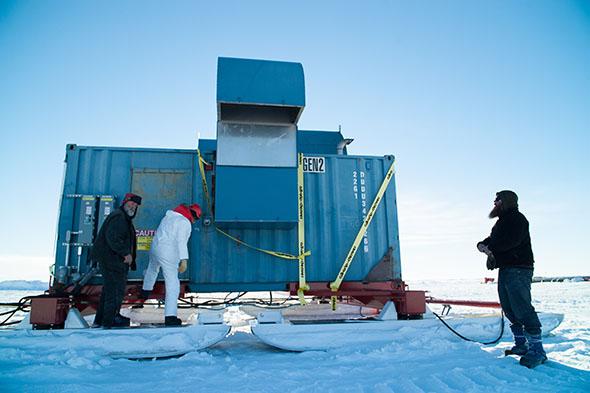A brief debate broke out over the radio on Jan. 25, 2013. “Anyone in drill camp know who’s in the Super Bowl?” someone asked.
“49ers and Seahawks,” replied a female voice.
“No—49ers and Falcons,” argued a male voice on the radio. They were both wrong. The 49ers and Ravens had earned their spots in the Super Bowl five days before. But these people could be forgiven their ignorance. They were living in near-complete isolation from the outside world: 30 people, including myself, inhabiting a small constellation of tents in the middle of the West Antarctic Ice Sheet.

Photo by J.T. Thomas
It was hard even to be sure of the date. Our camp sat just 380 miles from the South Pole—and there, at the height of the Antarctic summer, the sun never set. The roar of two 225,000-watt generators burning jet fuel reverberated through camp day and night—not for our comfort, but rather to power a hot-water drill. This behemoth occupied nearly a dozen cargo containers mounted on skis. It melted thousands of gallons of snow and pumped the heated water into a hose more than three-quarters of a mile long. People worked round the clock to unspool that hose, slowly, into a hole in the ice. The jet of hot water gushing from its nozzle melted the hole deeper and deeper—ever closer to the bottom of the ice sheet. The ice drillers constantly chatted on handheld radios to coordinate their opening and closing of water valves.
I followed this team of researchers and equipment operators down to Antarctica to witness a historic event: the first time that a subglacial lake, a huge pocket of liquid water hidden for millennia beneath Antarctica’s thick glacial ice, had ever been drilled and sampled.
There were many reasons for drilling into Lake Whillans, buried beneath half a mile of ice for up to 120,000 years. One of them is to understand what kind of life, if any, might survive outside of Earth, in the icy outer reaches of our solar system.
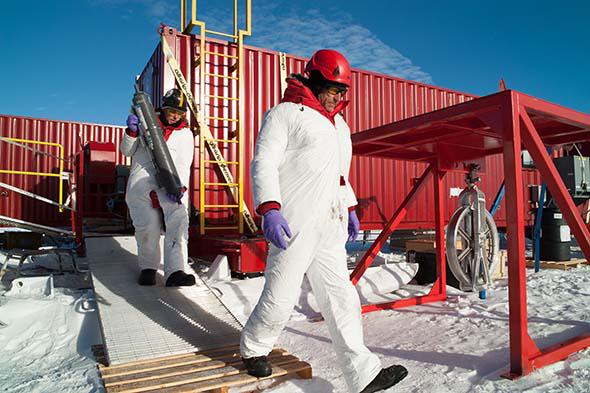
Photo by J.T. Thomas
If you read or write often about Antarctica, as I do, you frequently hear that one project or another will help us understand the possibility of extraterrestrial life. I often find such claims a bit trite—not dishonest, but based on a superficial analogy: Antarctica is cold, and so are most other planets and moons in our solar system. This alone, in my view, does not make Antarctica relevant for astrobiology. But the work on Lake Whillans and other subglacial lakes is providing some deep insight into why and how life might exist elsewhere in our solar system—especially on Europa, a moon orbiting Jupiter, which holds an ocean of liquid water beneath a crust of ice 10 to 20 miles thick.
* * *
The drill finally broke into Lake Whillans on Jan. 27, 2013. Bottles of its mineral-rich, honey-colored water were raised a day later. And soon after, a plastic cylinder was hoisted up, holding a column of mud punched from the lake’s bottom—ancient sediments representing the long-hidden bedrock face of Antarctica.
Dark glops of this alien mud spattered on the snow by the drill rig, smooth and gleaming like chocolate gelato. It was surprisingly scratchy, like wet cement, when rubbed between the fingers—full of tiny shards of bedrock pulverized by sliding glaciers during many thousands of years.
Mud is mundane—so easily overlooked—but to see it there was truly stirring. The West Antarctic Ice Sheet covers an area four times that of Texas—a plain of white in which each place looks like any other. I have spent seven weeks there during two expeditions, in 2007 and 2013. The horizon was usually identical and flat in every direction. No rock, no sand, not a speck of dirt—not a single vestige of the natural world that most of us live our daily lives in.
So when people saw that mud, they did pretty much what you’d expect: They scooped it off the snow and painted lines on their faces with it.
Experiments performed back home in the U.S. would reveal that Lake Whillans was brimming with life, half a million cells in every teaspoon of water—similar to the abundance of microbes in much of the world’s oceans. It was another example of the still-astonishing capacity of life to persist in just about every niche ever explored on Earth, from 230 degrees Fahrenheit volcanic vents on the ocean floor to deep ice in Greenland as cold as minus 30 degrees Fahrenheit to the stratosphere at altitudes up to 60,000 feet. It would be a bigger discovery if no life was found at all, said Brent Christner, one of the lead biologists on the project, from Louisiana State University, in the weeks before the lake was drilled.
What’s astounding was just how hospitable Lake Whillans turned out to be.

Photo by J.T. Thomas
It was easy to imagine the lake as profoundly hostile to life—cold, isolated from sunlight, and cut off the oxygen-rich atmosphere for possibly as much as 120,000 years. But it didn’t turn out to be so bad. Its water, at 31 F, was a tad warmer than the coastal seas surrounding Antarctica—waters that teem with krill, starfish, and whales—not to mention toothfish, weighing up to 100 pounds, which are commercially fished and served in restaurants around the world. (Salt and high pressure lower the freezing point of water, allowing it to stay liquid in oceans and deeply buried subglacial lakes several degrees below the traditional freezing point of 32 F.)
Most intriguing of all, the water in Lake Whillans actually contained oxygen—enough, theoretically, to support some common marine animals, like sea stars, sponges, and worms. These animals weren’t found in the lake, but it’s possible some small, rudimentary animals might inhabit its mud.
Although the lake sits under half a mile of ice, oxygen is constantly pumped into it from above. Ambient heat seeping up from the Earth’s interior melts a few penny-thicknesses of water from the underside of the ice sheet every year—liberating tiny air bubbles that were trapped when that ice formed from snow falling on the surface of the continent.
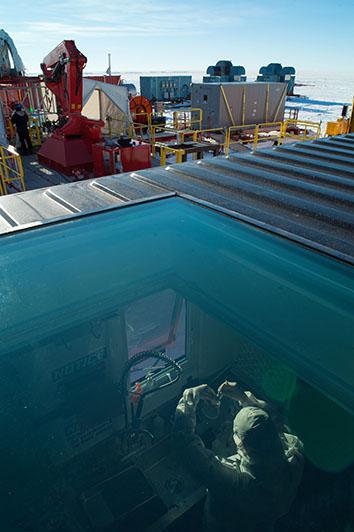
Photo by J.T. Thomas
This downward conveyor belt of oxygen isn’t unique to Lake Whillans. Members of a Russian team found something similar when they drilled into subglacial Lake Vostok, locked beneath 2½ miles of ice in another part of Antarctica. When the Russians’ drill penetrated the lake, a pressurized froth of water and gas bubbles surged hundreds of feet into the borehole—so powerful that it forced up 100,000 pounds of kerosene drilling fluid in the hole above it.
Lake Vostok had popped its cork like a freshly opened bottle of Champagne. Those bubbles provided evidence that the lake might be pressurized with up to 50 times more oxygen, gallon for gallon, than the world’s oceans—despite being isolated from the atmosphere for 15 million years. The search for life in Lake Vostok remains in progress, with researchers still uncertain whether microbes detected in its water originated from the lake or from the drilling fluid.
Roughly half of Antarctica’s 5 million square miles of glacial ice may sit on a bed of liquid water and mud—“the largest swamp in the world,” as it’s called by Slawek Tulaczyk, a glaciologist from the University of California–Santa Cruz who co-led the Lake Whillans drilling project. Much of that subglacial swamp may contain oxygen.
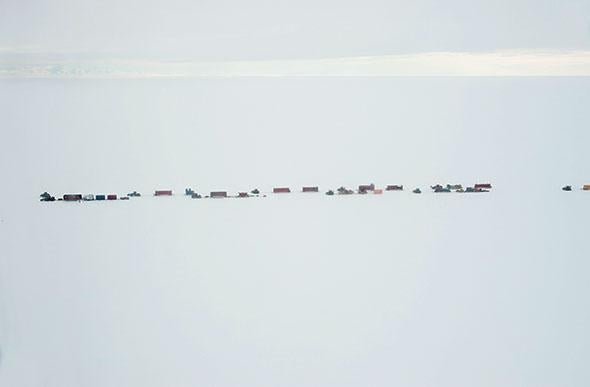
Photo by J.T. Thomas
It is the discovery of oxygen beneath the ice that transforms Antarctica’s subglacial lakes into a compelling analogy for how life might exist inside distant icy moons.
* * *
Six moons in our outer solar system are likely to have oceans of liquid water beneath an icy crust: Europa, Callisto, and Ganymede, which orbit Jupiter; Enceladus and Titan, which orbit Saturn; and Triton, which orbits Neptune. Together, they hold roughly 20 times as much liquid water as all of the rivers, oceans, and lakes on Earth. These moons are substantially smaller than Earth but contain a far higher percentage of water than Earth does.
It is often said that life requires liquid water. But with water now seeming pretty abundant in our solar system, the more stringent requirement for life may well be something else: an energy source that can power the growth of cells. This is where the finding of oxygen in Lake Whillans becomes important.
Most life on Earth subsists on energy from the sun: Photosynthetic plants and microbes use solar energy to split molecules of carbon dioxide into oxygen and carbon. Most other life on Earth piggy-backs on this solar energy scheme by running these chemical reactions in reverse. They use oxygen or some other reactive compound to “burn” carbon or other minerals and release energy.
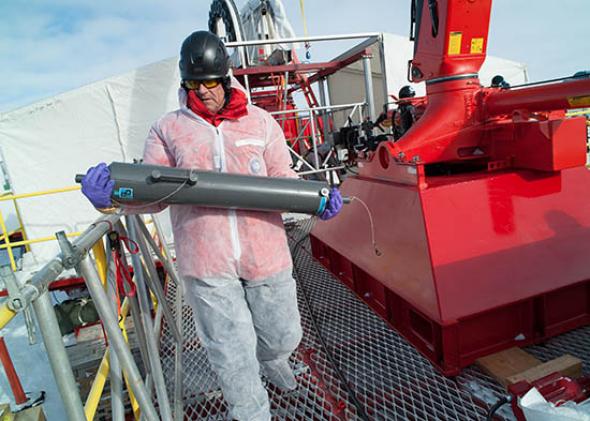
Photo by J.T. Thomas
Life subsisting beneath 10 to 20 miles of ice on Europa has no direct access to that energy—and neither does life in Lake Whillans. This subglacial lake shows how the flow of energy might still sustain life sealed under thick crusts of ice.
* * *
The temperature on Europa’s surface hovers between minus 260 F and minus 370 F—vastly colder than the lowest temperature ever recorded on Earth (minus 128.6 F, recorded at the Russians’ Vostok Station in Antarctica in 1983). It receives only about 4 percent as much sunlight per square foot as Earth does. It has no atmosphere to speak of. And yet somehow, Europa captures oxygen and other reactive compounds on its surface.
Earth-based telescopes and NASA’s Galileo space probe (which first flew by in 1997) have repeatedly detected signatures of oxygen on Europa’s surface, as well as sulfate and sulfur dioxide—two other reactive compounds that some microbes on Earth can use in place of oxygen. This supply of potentially life-giving oxidants comes from a bizarre interplay between Jupiter and its moons.
Europa’s orbit around Jupiter just happens to place it beside the most volcanically active object in the solar system: a yellow-white-orange sphere called Io, pimpled with several hundred volcanoes that spew sulfur dioxide and other gases into space. Its volcanic residue filters down onto Europa. There, it is cooked by radiation from Jupiter—producing the oxygen, sulfate, and other reactive chemicals seen on Europa’s surface. All told, Europa has gathered 60 million tons of sulfur from Io during its lifetime.
Magnetic and gravity measurements from Galileo suggest that Europa’s ocean sits on a rocky, Earth-like bottom. This solid, potentially mineral-rich base could supply the other half of the energy equation—iron or sulfur minerals that microbes could use as food. Just as microbes in Lake Whillans use oxygen from the ice above to burn iron, sulfur, and ammonia in the lake’s mud, alien life on Europa might use oxygen, sulfur dioxide, or sulfate to burn minerals on its own sea floor. The same broad formula for powering life applies to either place: Reactive, oxidizing chemicals derived from sunlight or radiation come from the ice above—and food to be burned by those chemicals comes from the rocks and mud below.

Image courtesy Britney Schmidt/Dead Pixel VFX/University of Texas at Austin
The potential hiccup is that Europa’s ice is 20 to 40 times thicker than that covering Lake Whillans—but even this might not prevent reactive chemicals from reaching the ocean below.
High-resolution images captured by Galileo show that Europa’s smooth surface is dotted with jumbled patches where blocks of ice seem to have tilted sideways. Planetary scientists now think that Europa’s ice shell is slowly churning and recycling itself. This is driven by warm ocean currents beneath the ice—and those currents are powered by intense tides and frictional heating as Europa’s interior strains and flexes under the force of Jupiter’s gravity. “Thermal forcing from the interior is high enough that it’s really affecting the ice,” says Britney Schmidt, a planetary scientist at Georgia Tech. “We may really be looking at quite a lot of heat.”
Schmidt calculates that these tumbled patches of ice probably overlie pockets of liquid water trapped in the shifting ice. Some of these pockets are quite big: One, beneath an area of chopped-up terrain named Thera Macula, is thought to hold more water than all of the Great Lakes combined.
This overturning of Europa’s ice could pump oxygen, sulfate, and sulfur dioxide into its ocean. “It actually ends up being relatively easy to oxidize Europa’s ocean,” says Kevin Hand, an astrobiologist at the NASA Jet Propulsion Laboratory—“even to the point where you’ve got enough oxygen to support complex life.”
These tossed-up blocks of Europan ice could also provide a compelling target for planetary exploration, since some of those Great Lake–sized pockets of water may sit only 2 miles beneath the ice surface.
Sending a space probe to drill through 20 miles of ice into Europa’s ocean represents a near-impossible task—but drilling through only 2 miles is much more doable. Researchers working in Antarctica and Greenland are already gaining expertise drilling through that thickness.
The Europa Clipper space probe now being considered for funding by NASA could set the stage for drilling into Europa’s hidden water by scouting out possible landing sites. Ice-penetrating radar on the probe could locate pockets of water near the surface that might become targets for future drilling missions. A magnetometer could estimate the depth—and even the saltiness—of the hidden ocean. An infrared spectrometer could make improved measurements of reactive chemicals like oxygen or sulfate on the surface. A mass spectrometer might even allow the probe to analyze water from Europa’s ocean: Plumes of water vapor sometimes seen around the moon are thought to come from ocean water forced up, in brief spurts, by the shifting of ice blocks.
If Europa Clipper is funded, it could launch sometime after 2020. Antarctica, meanwhile, will serve as a proving ground for developing tools needed to explore Europa and the other icy moons of our solar system.
